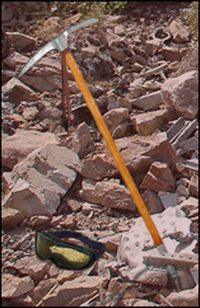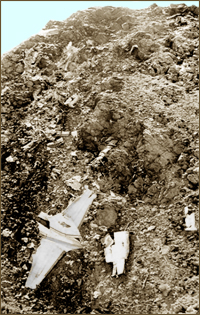
( Read Part I )
The White Mountains ranged low and drab to the east, and the Sierra Nevadas rose grand and snow capped to the west. Crisp wind rippling down the valley fumbled over a rusting gas station on the outskirts of Bishop with a sound like strong men shaking out great sheets of canvas.
“You see that little thing at the top?” The kid pumping gas pointed around the back of my VW van. “That little thing sticking up?” The crest line was rugged, but had no distinct features except for a very small projection where he pointed. “I don’t know what it is but somebody put something up there where the plane hit.”
He told me the fire had burned for hours. On dirt bikes he and a buddy had tried to get to the site, but even with all the blazing airplane fuel, the moonless night was so dark they could not see five feet in front of them. And if they kept going the chances were good they would have ended up at the bottom of one of the steep ravines that scar the slopes.
I tried to align the marker on the eastern crest line with the gas station and one of the Sierra Nevada peaks, then headed back the way I had come on Route 395. The first chance I got I turned left onto a dirt road that seemed to run almost directly to the base of the slope below the marker. When the road ran out I parked on the flattest patch of ground I could find and turned off the engine. I was already high enough above the valley floor to have an unobstructed view for miles to the north and south. The gas station was a small box a long way off.
It was about 2:00 in the afternoon. The crash had occurred in complete darkness between 8:24 and 8:28 pm. I reckoned I had maybe three and a half hours to find the point of impact and get my act together before it would be too dark to see my hand in front of my face. I donned my goggles, hoisted my pack on my back, looped the strap of the ice axe over my right wrist, and began climbing a ravine that seemed to run straight up the slope to a vertical rise just below the marker.
It occurred to me that I could easily lose course and waste precious time wandering around. The marker was already almost concealed by the outcropping on which it rested and I knew that very soon I would not be able to see it at all. I decided to remain in the ravine until it ran out, then try to stay aligned with it behind me as I approached the crest.
I could not have invented a more strenuous approach. From bottom to top, the ravine was full of sharp, broken rocks of all sizes that I climbed over and around, drenched in sweat, hands and feet aching.
Around 4:30 the ravine flattened out onto a slope from which rose a sixty-foot-high wall of rocks. I was pretty sure the marker – whatever it was – stood on a plateau straight above me. I was exhausted. Wearier than I had ever been in my life, and a biting wind seemed determined to carry away what little energy remained.

